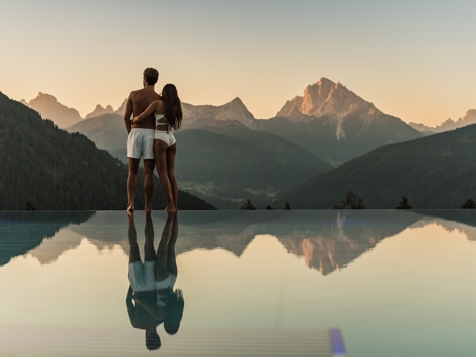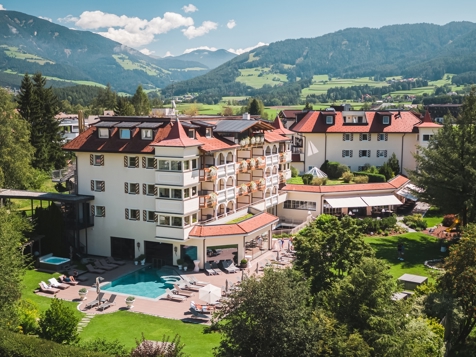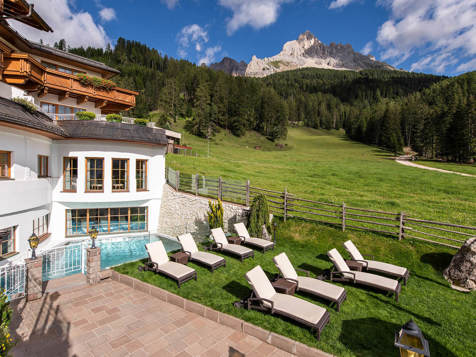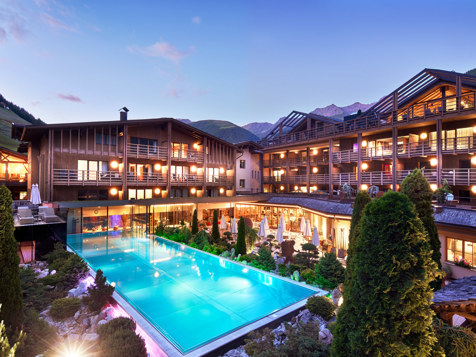Holidays in the Dolomites
The Dolomites are a true paradise, unrivalled in their uniqueness. The Three Peaks are among the most famous rocky peaks in the northern Italian Alps.
But they are by no means their only attraction. Mountaineers, hikers and winter sports enthusiasts are offered many other alpine challenges.
Where are the Dolomites?
The majestic Dolomites are a mountain range in the Southern Limestone Alps and extend across north-east Italy, over the provinces of South Tyrol, Trentino and Belluno. The main access points to this breathtaking mountain range are the towns of Bozen, Brixen, Bruneck, Cortina d'Ampezzo and Belluno. Thanks to a well-developed transport network, the Dolomites can be easily reached from there by car, bus, train or, for example, by plane from Bozen.
Our map shows the Dolomites regions of the province of South Tyrol, from Hochpustertal to Mt. Kronplatz, Alta Badia, Gröden and the Seiser Alm-Schlern area to Eggental. The highest peak in the Dolomites is the Marmolada, with an altitude of 3,343 metres.
History of the Dolomites

In Tiers and St. Zyprian, you will enjoy a wonderful view of the wonderful natural landscape and of the legendary Mt. Rosengarten.
Internet Consulting - Fabian Auer
The bizarre peaks of Puez Geisler are an impressive mountain ridge, which you can see in Villnöss.
Internet Consulting
Aerial view of Peitlerkofel/Sass de Putia, in the Dolomites (2875 meter) the highest summit of the Peitlerkofel/Putia Group.
Internet Consulting - Stefan TolpeitThe Dolomites are a group of mountains in the Alps that are around 250 million years old and consist mainly of sedimentary rock and limestone. Today, they are characterised by their varied landscape of rugged rocks and gentle mountain meadows. The Dolomites, which were hotly contested in gruelling trench warfare during the First World War, have developed into a popular hiking and excursion destination in recent decades - popular with locals and visitors from afar alike.
It is no coincidence that the Dolomites, named after the French geologist Déodat de Dolomieu, have been a UNESCO World Heritage Site since 2009. The unique flora and fauna contribute significantly to the monumental beauty of the mountain range. The protection of nature and the landscape remains important, making it possible for future generations to enjoy this paradise in Italy.
Pure nature paradise

at dusk
Tourismusverein Welschnofen
Three peaks and Paternkofel
Vincenzo De Santis / Fotolia.com
Dreamlike ski tour near the Three Peaks with view of Mt. Paternkofel
Alpinschule Sexten Drei Zinnen
The Geisler Group in Villnöss is located in the heart of Puez Geisler Nature Park in the Dolomites. It is a wonderful hiking area for the whole family.
Internet Consulting - Fabian Auer
The breath-takingly beautiful mountain lake in the Dolomites is located at the foot of the picturesque Mt. Seekofel.
Internet Consulting - Stefan TolpeitWith the Three Peaks, the Fanes-Sennes-Prags Nature Park, the Marmolada, the Rosengarten and the Schlern massif, the Dolomites are undoubtedly one of the favourite destinations for all amateur geologists and nature lovers in the Alps.
Five nature parks
The Dolomites include five different nature parks and, in addition to the provinces of South Tyrol and Trentino, also extend over the regions of Veneto and Friuli, including the Marmolada group, the Ampezzo, Belluno and Friuli Dolomites.
Different mountain groups
The most important mountain groups in the Dolomites include
- Sella Group
- Rosengarten and Schlern
- Langkofel massif
- Puez-Geisler Group
- Latemar Group
- Prags Dolomites
- Sexten Dolomites with the Three Peaks
In which season are the Dolomites at their most beautiful?

The impressive mountains are located in the Sexten Dolomites and are a very famous photo spot.
Internet Consulting - Stefan Tolpeit
Unique fixed-rope route right next to the Three Peaks
Alpinschule Drei Zinnen - Daniel Rogger
The relatively easy fixed-rope route can be reached from Tiers and leads to the highest peak of Rosengarten Group.
Seiser Alm Marketing - Helmuth RierWhen the first flowers sprout in spring and the mountain landscape is transformed into a sea of blossom, the first mountain enthusiasts are already drawn to the lofty heights.
Summer holidays in the Dolomites
The ideal time for hiking, climbing and biking in the Dolomites is in summer from June to September. In the fresh mountain air, you can leave the stresses of everyday life far behind you. Whether in Eggental, on the Seiser Alm, in Gröden, in Alta Badia, on Mt. Kronplatz or in Hochpustertal – via ferratas, high-altitude tours and alpine hikes are the perfect outdoor activities for your summer holiday.

Wonderful snowy landscape
TG San Vigilio-San Martin - Coco
Discover the beauty of the South Tyrolean mountain world in winter by a ski tour to Mt. Dürrenstein.
Internet Consulting - Piergiorgio Caruso
Corvara in winter
dolomitenmaniac / Fotolia.com
Heiligkreuzkofel and the Armentara fields. The hike below Heiligkreuzkofel leads to the homonymous hospice and chapel.
Internet Consulting
In the autumn months, the larches change into golden colours, creating a unique natural scenery.
Internet Consulting - Benedikt Trojer
in autumn
suteracher / Fotolia.comIn autumn, the Dolomites region in Italy comes to rest again. The fresh and clear autumn air still attracts the odd mountain sports fan to the mountains – the views could not be better now!
Winter holidays in the Dolomites
When the days get shorter and colder and the first blanket of snow covers the Dolomites, the lovely winter landscape is transformed into a paradise for skiers, cross-country skiers, snowshoe hikers and ski tourers. The ideal snow conditions ensure an incomparable skiing holiday in the Dolomites and numerous events such as the Ski World Cup in Gröden, the Balloon Festival in Toblach or the Biathlon World Cup in Antholz are a highlight for visitors from near and far every year.
For more information, accommodation tips and travel guides, go to dolomites.com


































